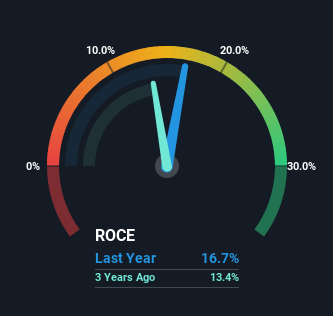- United States
- /
- Building
- /
- NYSE:AWI
Here's What To Make Of Armstrong World Industries' (NYSE:AWI) Decelerating Rates Of Return

If we want to find a potential multi-bagger, often there are underlying trends that can provide clues. In a perfect world, we'd like to see a company investing more capital into its business and ideally the returns earned from that capital are also increasing. Basically this means that a company has profitable initiatives that it can continue to reinvest in, which is a trait of a compounding machine. In light of that, when we looked at Armstrong World Industries (NYSE:AWI) and its ROCE trend, we weren't exactly thrilled.
Return On Capital Employed (ROCE): What Is It?
If you haven't worked with ROCE before, it measures the 'return' (pre-tax profit) a company generates from capital employed in its business. To calculate this metric for Armstrong World Industries, this is the formula:
Return on Capital Employed = Earnings Before Interest and Tax (EBIT) ÷ (Total Assets - Current Liabilities)
0.17 = US$255m ÷ (US$1.7b - US$186m) (Based on the trailing twelve months to September 2023).
Therefore, Armstrong World Industries has an ROCE of 17%. In absolute terms, that's a pretty normal return, and it's somewhat close to the Building industry average of 16%.
View our latest analysis for Armstrong World Industries

Above you can see how the current ROCE for Armstrong World Industries compares to its prior returns on capital, but there's only so much you can tell from the past. If you're interested, you can view the analysts predictions in our free report on analyst forecasts for the company.
What Does the ROCE Trend For Armstrong World Industries Tell Us?
Over the past five years, Armstrong World Industries' ROCE and capital employed have both remained mostly flat. It's not uncommon to see this when looking at a mature and stable business that isn't re-investing its earnings because it has likely passed that phase of the business cycle. So unless we see a substantial change at Armstrong World Industries in terms of ROCE and additional investments being made, we wouldn't hold our breath on it being a multi-bagger.
On a side note, Armstrong World Industries has done well to reduce current liabilities to 11% of total assets over the last five years. Effectively suppliers now fund less of the business, which can lower some elements of risk.
The Bottom Line
In a nutshell, Armstrong World Industries has been trudging along with the same returns from the same amount of capital over the last five years. Although the market must be expecting these trends to improve because the stock has gained 59% over the last five years. However, unless these underlying trends turn more positive, we wouldn't get our hopes up too high.
On a separate note, we've found 1 warning sign for Armstrong World Industries you'll probably want to know about.
If you want to search for solid companies with great earnings, check out this free list of companies with good balance sheets and impressive returns on equity.
New: Manage All Your Stock Portfolios in One Place
We've created the ultimate portfolio companion for stock investors, and it's free.
• Connect an unlimited number of Portfolios and see your total in one currency
• Be alerted to new Warning Signs or Risks via email or mobile
• Track the Fair Value of your stocks
Have feedback on this article? Concerned about the content? Get in touch with us directly. Alternatively, email editorial-team (at) simplywallst.com.
This article by Simply Wall St is general in nature. We provide commentary based on historical data and analyst forecasts only using an unbiased methodology and our articles are not intended to be financial advice. It does not constitute a recommendation to buy or sell any stock, and does not take account of your objectives, or your financial situation. We aim to bring you long-term focused analysis driven by fundamental data. Note that our analysis may not factor in the latest price-sensitive company announcements or qualitative material. Simply Wall St has no position in any stocks mentioned.
About NYSE:AWI
Armstrong World Industries
Engages in the design, manufacture, and sale of ceiling and wall solutions in the Americas.
Solid track record with adequate balance sheet.

